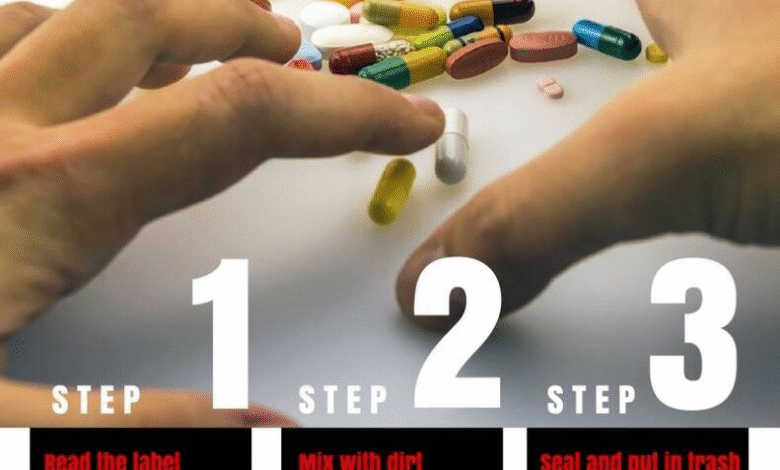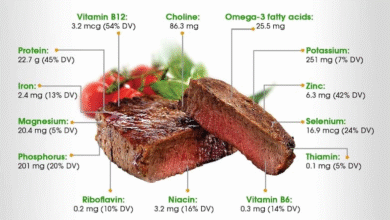Safe Disposal of Prescription Medications: What You Need to Know

The safe disposal of prescription medications is a crucial aspect of public health that cannot be overlooked. As highlighted by HHS Secretary Robert F. Kennedy Jr., improper disposal methods can have dire consequences, including environmental contamination and increased risk of substance misuse. On National Prescription Drug Take Back Day, celebrated on April 26, Americans are encouraged to actively participate in dropping off their unused prescriptions at designated medication drop-off sites. The Drug Enforcement Administration (DEA) has made this process easier by establishing free and anonymous collection points across the nation. Educating the public on how to dispose of medications responsibly, including knowing the FDA flush list for certain drugs, is vital in the fight against opioid addiction prevention and ensuring safety for all.
The effective management of unused prescription drugs is not just a personal responsibility but a community health concern. With the shadow of opioid abuse looming, individuals are urged to find responsible ways to handle leftover pharmaceuticals. Participating in community initiatives, such as National Prescription Drug Take Back Day, provides an opportunity for safe and proper medication disposal. It is crucial to utilize available resources, like medication drop-off locations, to ensure these substances do not pollute our water supply or pose a risk of misuse. By following the proper disposal guidelines, including those on the FDA’s guidance for flushing certain medications, we can protect our environment and promote public safety.
Understanding the Importance of Safe Disposal of Prescription Medications
Disposing of prescription medications safely is crucial for public health and safety. With the past few decades seeing a substantial rise in opioid prescriptions, it’s imperative for individuals to recognize the risks posed by improperly discarded drugs. Unused medication left in cabinets is not only vulnerable to theft and misuse but can also contribute to environmental pollution. In his addresses on National Prescription Drug Take Back Day, Secretary Kennedy underscores the urgency of turning in unused medications to designated drop-off points, helping to combat prescription drug abuse and protect local communities.
The proper disposal of prescription medications prevents potential access by children, pets, and even those struggling with substance abuse. Engaging in safe disposal practices mitigates the risk of accidental poisoning or overdose. Furthermore, properly disposing of medications safeguards our drinking water supply and local ecosystems from the harmful effects of pharmaceutical contaminants. As promoted by organizations like the DEA, participating in events such as National Prescription Drug Take Back Day offers a community-focused solution to this pressing issue.
National Prescription Drug Take Back Day: A Call to Action
National Prescription Drug Take Back Day serves as an essential reminder for all Americans to assess their home medicine cabinets and remove unused medications responsibly. By participating in this event, individuals not only relieve themselves of unwanted drugs but also contribute to a larger movement aimed at curbing prescription drug misuse and preventing potential overdoses. The DEA’s initiative establishes free and anonymous medication drop-off sites, underscoring the importance of accessibility for all.
In the recent years, the impact of National Prescription Drug Take Back Day has been significant, with impressive amounts of medication being returned for safe disposal. On October 2024, over 629,950 pounds of medications were collected, highlighting the community’s role in managing this crucial public health issue. This collective action not only reduces the risk of medication misuse but also fosters awareness about responsible drug disposal. Individuals who miss the take back day can still find year-round drug drop-off sites, reinforcing the continuous need for caring and responsible medication disposal.
The Dangers of Flushing Prescription Medications
Flushing medications down the toilet may seem convenient, but it presents serious risks that many do not fully understand. Once these substances enter the water system, they can affect wildlife and the purity of drinking water. Even small amounts of pharmaceuticals can disrupt aquatic ecosystems and potentially expose humans to dangerous contaminants. Secretary Kennedy’s warning resonates with the need to educate the public on the environmental implications of their disposal choices, urging them to think twice before resorting to flushing.
While the FDA has established a ‘Flush List’ that denotes certain medications deemed safe to flush, such as specific opioids, it is essential that consumers are informed about which medications fall under this category. Many medications not listed should not be disposed of in this manner. Educating the public on the perils of flushing, along with promoting alternative methods of disposal, is vital to protect both human and environmental health. Advocacy efforts must focus on proper waste management practices to diminish potential hazards.
Medication Drop-Off Sites: Convenience and Safety
The establishment of medication drop-off sites nationwide by the DEA reflects a growing recognition of the need for safe medication disposal methods. These sites provide an easy, anonymous way for users to rid themselves of unwanted prescriptions without fear of repercussions. Locations are strategically selected to ensure that they are accessible for everyone, thereby encouraging community participation in reducing the prevalence of unused medications.
Having medication drop-off sites available year-round means that even if someone misses National Prescription Drug Take Back Day, they can still take action when it comes to their unused drugs. This year-round accessibility is a vital component of ongoing opioid addiction prevention efforts. By offering safe disposal options, these sites contribute significantly to public safety and the prevention of prescription drug abuse, ensuring that medications are disposed of in a manner that protects both people and the environment.
The Role of the FDA in Medication Disposal Guidance
The FDA plays a critical role in providing guidance on the safe disposal of medications, helping to educate the public on the proper methods. Their recommendations not only include advice on which medications are safe to flush but also outline best practices for discarding other forms of pharmaceuticals. This comprehensive approach ensures that individuals are aware of their options, reducing potential risks associated with improper disposal.
In addition to their flushing guidelines, the FDA emphasizes the importance of following local regulations when disposing of medications. Many communities offer specific instructions for proper disposal, and understanding these can significantly minimize risks to health and the environment. By collaborating with organizations like the DEA and health services, the FDA aims to enhance public awareness and promote best practices for safe medication disposal throughout the country.
Educating Communities on Prescription Drug Safety
Community education plays an essential role in addressing the growing concerns surrounding prescription drug safety and misuse. Through various campaigns, public service announcements, and local events such as National Prescription Drug Take Back Day, organizations aim to inform the public about the importance of responsible medication management. By providing informative resources and interactive events, communities can foster a culture of awareness and accountability regarding drug use and disposal.
Engaging various stakeholders, including healthcare providers, educators, and law enforcement, can amplify the message of drug safety. Schools can introduce programs that address the dangers of prescription drug misuse, while health departments can provide training on medication disposal practices. By fostering a collaborative approach, communities can work together to create safer environments, significantly lowering the risks of opioid addiction and misuse.
Challenges in Prescription Medication Disposal
Despite the availability of medication disposal options, challenges still exist in encouraging proper disposal practices across various demographics. Many individuals remain unaware of the dangers associated with leaving unused medications at home or disposing of them improperly. Additionally, misconceptions about flushing medications contribute to this persistent issue, highlighting the need for ongoing education and outreach efforts. To effectively tackle these challenges, targeted strategies should be implemented to resonate with specific communities and demographics.
Moreover, consider the barriers some individuals face when accessing medication drop-off sites, such as transportation issues or lack of information about location. Addressing these obstacles is pivotal in ensuring that everyone has the opportunity to dispose of their medications safely. Developing mobile collection units, for instance, could alleviate some of these access issues while promoting a proactive approach to medication disposal.
The Connection Between Safe Medication Disposal and Opioid Addiction Prevention
Proper disposal of prescription medications directly contributes to the prevention of opioid addiction, a public health crisis affecting communities nationwide. Many individuals who misuse prescription drugs often obtain them from friends or family members, accentuating the importance of safe disposal practices. By ensuring that unused medications are turned in to safe, designated drop-off locations, communities can significantly reduce the chances of drugs falling into the wrong hands.
Furthermore, education initiatives aimed at reducing the stigma surrounding opioid addiction can also resonate in the context of safe disposal. When communities openly discuss the impact of prescription drug misuse and the importance of responsible medication management, they foster an environment conducive to prevention efforts. Collaborative approaches can effectively bridge the gap between individuals’ awareness of proper disposal and their actions, ultimately assisting in the fight against opioid addiction.
Regulatory Framework and Safe Medication Disposal
Regulatory frameworks surrounding medication disposal provide crucial guidelines for safe practices and help mitigate the risks associated with prescription drug misuse. Rules established by agencies such as the DEA and FDA outline the acceptable methods for drug disposal, ensuring public safety and environmental protection. By understanding and adhering to these regulations, individuals and healthcare providers can contribute to a more responsible approach to medication management.
Moreover, staying informed about legislation related to the disposal of medications can empower communities to advocate for improvements in existing regulations or the creation of new policies. Engaging with lawmakers and health organizations to discuss issues related to safe disposal practices can lead to enhanced prevention measures, assisting in the ongoing effort to reduce medication misuse. Regulatory changes can also pave the way for innovative solutions, such as centralized disposal systems and community education programs.
Frequently Asked Questions
What is the importance of safe disposal of prescription medications?
Safe disposal of prescription medications is essential to prevent accidental ingestion and misuse, particularly to combat opioid addiction. Improper disposal, like flushing, can contaminate water supplies, posing risks to public health. Events like National Prescription Drug Take Back Day provide an opportunity for safe disposal through designated collection sites.
How can I safely dispose of my unused prescription medications?
You can safely dispose of unused prescription medications by taking them to medication drop-off sites promoted by the DEA, especially during National Prescription Drug Take Back Day. These sites accept various medications and help prevent misuse and environmental contamination.
What should I know about the FDA flush list for medication disposal?
The FDA flush list identifies specific medications deemed safe to flush down the toilet due to their potential danger if left unsecured at home. This includes certain opioids like OxyContin and Percocet. Medications not on this list should be disposed of using other safe methods, such as taking them to medication drop-off sites.
When is National Prescription Drug Take Back Day and how does it help?
National Prescription Drug Take Back Day occurs twice a year, with the next event on April 26. This initiative helps Americans safely dispose of unused or expired prescription medications at designated drop-off sites, significantly reducing the risk of substance misuse and preventing addiction.
Are there year-round options for the safe disposal of medications?
Yes, the DEA maintains permanent medication drop-off sites across the country, providing year-round opportunities for the safe disposal of prescription medications. These sites operate continuously, ensuring communities can safely dispose of medications at any time.
What are the risks of not disposing of medications properly?
Not disposing of medications properly can lead to accidental poisoning, drug misuse, and environmental contamination. Flushing medications can release harmful substances into the water supply, affecting local ecosystems and human health. Safe disposal methods, like those available on National Prescription Drug Take Back Day, greatly mitigate these risks.
How can I find local medication drop-off sites for safe disposal?
To find local medication drop-off sites, you can visit the DEA’s website or contact local pharmacies, as many also participate in the safe disposal of prescription medications initiatives. These resources help ensure you’re disposing of medications safely and responsibly.
| Key Points | Details |
|---|---|
| Health and Human Services Urging Proper Disposal | HHS Secretary Robert F. Kennedy Jr. emphasizes safe disposal of prescription medications, especially on National Prescription Drug Take Back Day. |
| Flushing Medications is Dangerous | Flushing prescriptions can contaminate water systems with harmful substances, potentially affecting public health. |
| FDA’s Flush List | Certain medications like Vicodin, OxyContin, and Percocet are safe to flush, but others not on this list should be disposed of through designated sites. |
| National Prescription Drug Take Back Day | Promoted by the DEA, this event helps prevent drug misuse and addiction; over 629,950 pounds of medication were collected on the last event. |
| Year-Round Drug Drop-Off Sites | The DEA provides continuous access to drug take-back sites for proper disposal throughout the year. |
Summary
Safe disposal of prescription medications is crucial for public health and environmental protection. As emphasized by HHS Secretary Robert F. Kennedy Jr., improper disposal methods, such as flushing, pose serious risks by contaminating water supplies. Americans are encouraged to utilize designated drop-off sites, especially during National Prescription Drug Take Back Day, to ensure that their unused medications are disposed of safely. By following the guidelines set by the DEA and the FDA, we can help prevent misuse and protect our communities.




